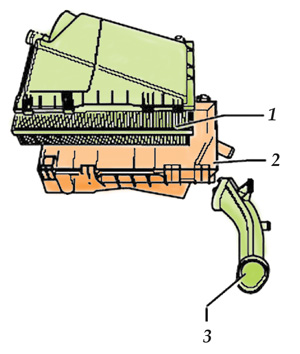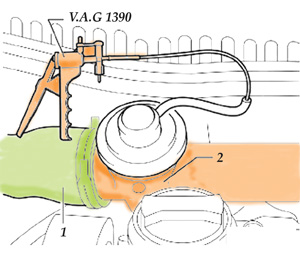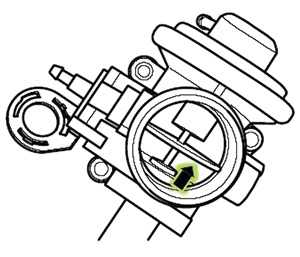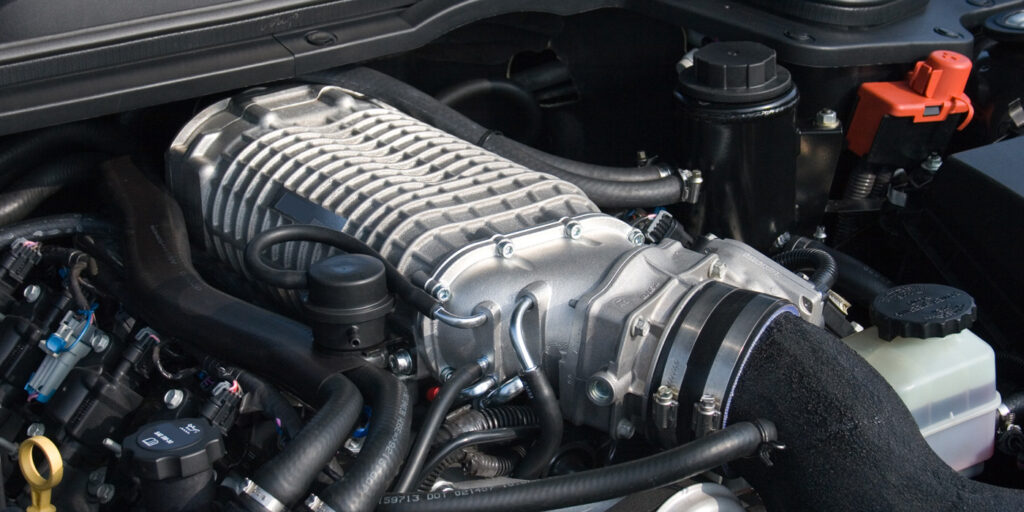A customer recently noticed that his 2002 VW Beetle turbo diesel had lost its pep. After he scheduled an appointment, I went to work researching the symptom he described.
Perform repair steps 1 through 9. If any of these steps reveals a problem, repair or adjust as necessary and perform a road test prior to continuing on to step 10.
A hand vacuum pump may be required to diagnose the problem.
Applicable Vehicles:
• 1998-2003 New Beetle with 1.9L TDI (ALH);
• 1999-2003 Golf and Jetta with 1.9L TDI (ALH); and
• 2001-2003 Jetta Wagon with 1.9L TDI (ALH).
Repair Procedure:
Note: Review safety procedures before beginning.
1. ECM ground connection:
- Inspect the ECM ground (GND) connection for corrosion, poor connection or no connection.
2. Injection pump timing:
- Check the start of the injection pump timing.
- Tip: An adjustment to the upper range is advised.
 3. Snow screen (if applicable) at intake air duct:
3. Snow screen (if applicable) at intake air duct:
- Check the snow screen, located below the left front fender in the air duct (See 3, Fig. 1), and clean as necessary.
- Inspect the air cleaner element (See 1, Fig. 1) for proper installation.
- If the air cleaner element is deformed due to improper installation, this may cause the MAF sensor to fail.
- Replace the air cleaner element as necessary.
- Tip: Always check with VW or your local supplier for latest part revisions.
4. Vacuum hoses:
- Check the integrity of all vacuum hoses and connections, and repair as needed.
5. EGR valve and intake manifold air flap (integrated in EGR valve):
-
 Remove the intake hose (See 1, Fig. 2) at the EGR valve.
Remove the intake hose (See 1, Fig. 2) at the EGR valve. - Remove the vacuum hose from the EGR valve (See 2, Fig. 2).
- Connect the hand vacuum pump to the EGR valve (See 2, Fig. 2).
- Apply vacuum and make sure that the air flap (See arrow, Fig. 3) opens and closes freely.
If the flap does not open and close freely:
- Replace the EGR valve/flap.
6. MAF sensor and EGR valve including solenoid valve:
- Check for correct function of the MAF sensor and EGR valve, including the solenoid valve.
- Tip: Since both systems work closely together, if one system malfunctions it will directly affect the function of the other. Therefore it’s important to follow the procedure carefully.
-
 In addition, the MAF sensor must be full-load tested.
In addition, the MAF sensor must be full-load tested. - If the MAF sensor readings are out of tolerance (even if no MIL ON condition or DTC is present), before replacing MAF sensor or EGR solenoid valve:
- Ensure that the wiring is OK, and electrical connections are clean and functioning properly.
- If wiring is OK and electrical connectors are clean and functioning property:
- Replace the MAF sensor.
- If the MAF sensor failed full-loaded test, and after replacement of MAF sensor the full-load value still cannot be attained:
- Check the turbocharger.
7. Crankcase ventilation system:
- Inspect and verify that it’s functioning to OEM specifications.
8. Engine oil level:
- Check and adjust it to the proper level if necessary. Do not overfill.
9. Fuel quality:
- If the condition occurs suddenly, the fuel quality may be inferior.
- If fuel is suspected to be of poor quality:
- Drain and refill with known good quality fuel.
10. Check for carbon buildup:
If all previous items are functioning according to specifications, and the vehicle still exhibits poor throttle response, it may be necessary to physically inspect the EGR valve and intake manifold as there may be (in higher-mileage vehicles) excessive carbon build-up in the intake manifold and/or EGR valve.
Tip: While some carbon buildup is normal and not a concern, excessive carbon buildup is related to fuel quality and soft driving behavior (operation at low speeds and short driving distances), under extremely cold and damp operating conditions.
To inspect for carbon buildup:
• Remove the EGR valve and inspect and record the depth of carbon in the valve and intake manifold.
Normally carbon buildup is not a concern; a problem may occur only if it’s excessive (greater than 10 mm). If the carbon layer in the EGR valve and/or intake valve is greater than 10 mm (50 to 60% clogged):
• Replace the EGR valve and/or intake manifold.
If the EGR cooler is clogged more then 50 to 60% in its flow area:
• Replace the EGR cooler.
If new parts are not available, or if it’s more economical, the intake manifold and EGR cooler can be cleaned.
Tip: Prior to cleaning, the intake manifold and EGR cooler must be removed from the engine to ensure that no carbon particles enter the engine.
Written by ALLDATA Technical Editor Eric Seifert, an ASE-certified Master Technician and Engine Machinist.
Technical service bulletin courtesy of ALLDATA.
For additional information, visit www.alldata.com.











